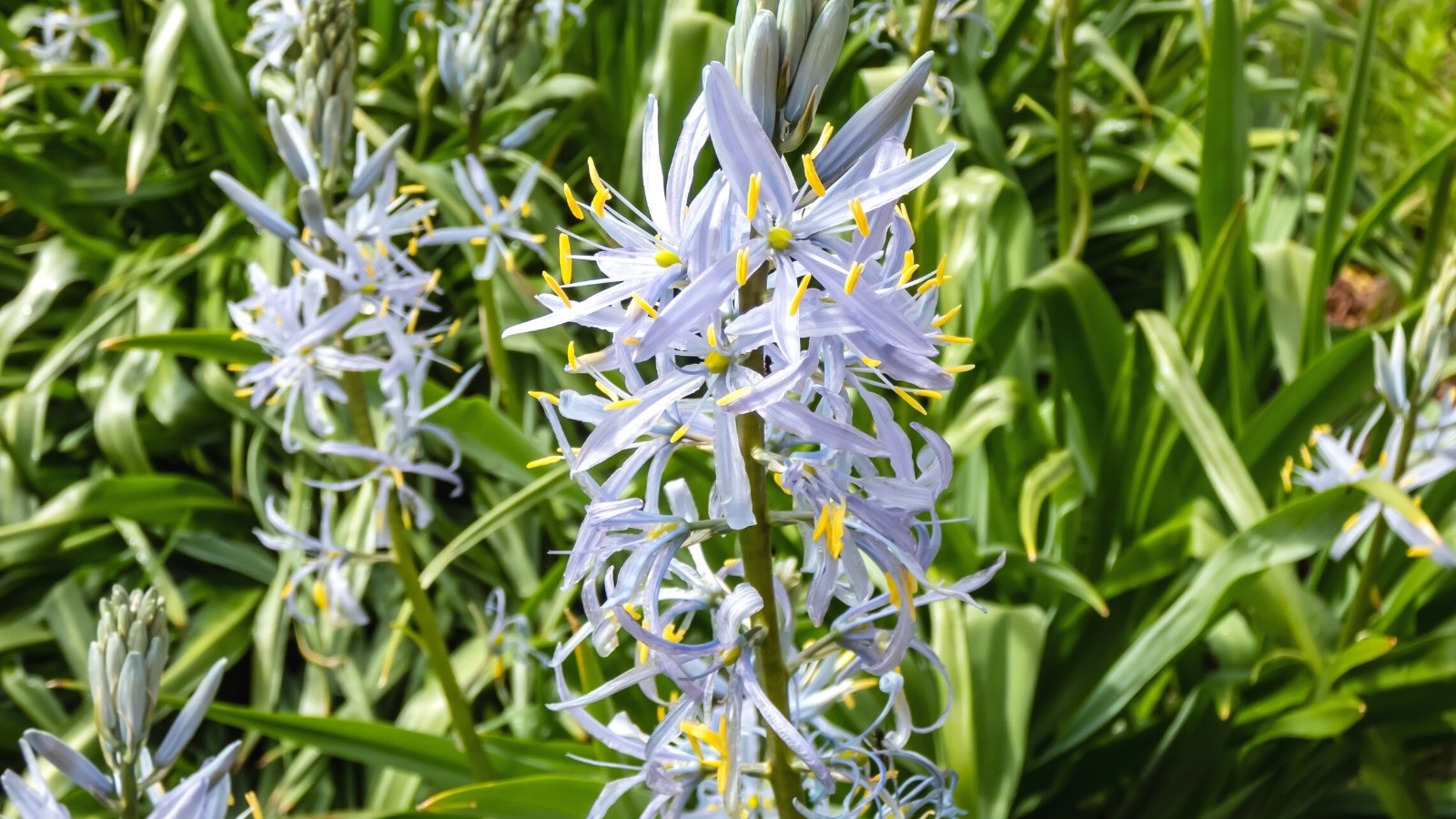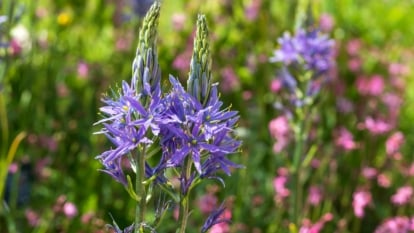While most of the spring-blooming bulbs we love are native to Eurasia, the camas flower is here to prove that North American native bulbs can also be beautiful! With species native to the Pacific Northwest and East Coast, many gardeners can find a camas flower that’s well suited to your area.
No matter which species you plant, you can expect to enjoy impressively tall flower stalks covered in star-shaped flowers. Their height provides a tall garden backdrop and also offers a nice contrast to shorter spring ephemerals like trout lilies and bleeding hearts.
Not only are camas flowers beautiful, but they’re also easy to grow, as long as you plant them in the right environment! Stay with me to learn how to plant and grow these plants so they provide you with flowers for years to come.
Overview
| | |
What Is It?
 Brighten wet yards with stunning star-shaped camas flower blooms.
Brighten wet yards with stunning star-shaped camas flower blooms.
Also known as quamash and wild hyacinth, camas flowers thrive in moist, sunny areas, where they spend the winter underground as bulbs When spring arrives, the bulbs send up thin green flowers followed by a tall flower stem covered in star-shaped blooms.
Since these plants can tolerate moist and heavy soils, they’re a great option if your yard is too wet for popular spring bulbs like tulips and daffodils.
Characteristics
 Camas bulbs transform into stunning fields of colorful spring flowers.
Camas bulbs transform into stunning fields of colorful spring flowers.
While the Camissa genus contains six species, all of these plants share similar characteristics. First, they all emerge from vegetative bulbs that resemble pearl onions. These bulbs multiply over time, so a single camas plant can eventually turn into a field of flowers.
The bulbs remain dormant during the winter as they store their energy for the upcoming spring. The bulbs sometimes send up a rosette of slender green leaves in late winter or early spring. As the plants grow, the leaves grow upright and almost resemble blades of grass, which makes sense when you consider these plants are monocots.
By mid-spring, the plants have focused their energy on producing flower stalks that stand one to three feet tall. After early spring bloomers like daffodils and tulips fade, the stalks explode with six-petal, star-shaped flowers. The blooms feature delicate, slender petals and long stamens.
Depending on the species and variety, the flowers may appear dark purple, periwinkle, pink, white, or lavender. The flowers near the bottom of the stalk emerge first, and the uppermost buds open last. When all is said and done, camas flowers bloom for a few weeks. They then produce hollow, round, airy pods filled with multiple seeds.
By late summer, the flower stalk and foliage have faded away, and the plants seem to disappear. However, the bulbs sit underground, waiting for the following spring to arrive.
Native Area
 Camas species flourish in the Pacific Northwest’s temperate environments.
Camas species flourish in the Pacific Northwest’s temperate environments.
Most camas species are native to the Pacific Northwest. They thrive in the temperate, moist environments found in this region. Since they prefer full sun or just a few hours of daily shade, you’ll often find them in open meadows or woodland edges in Oregon, Washington, and British Columbia.
However, the Atlantic camas (Camassia quamash subsp. quamash) calls much of the eastern United States home. Like other camas species, it thrives in areas with rich, moist soil.
Use as a Food Source
 Indigenous tribes harvested and cooked camas bulbs for sustenance.
Indigenous tribes harvested and cooked camas bulbs for sustenance.
Indigenous peoples use the bulbs of camas flowers as a food source. Since these edible bulbs closely resemble those of the poisonous death camas, people often dug the bulbs in the spring or early summer when the flowers allowed for easy identification. After digging the bulbs, people often roasted them in a firepit or boiled them in water.
Camas bulbs taste a bit like extra-sweet sweet potatoes. Since the bulbs contain a lot of prebiotic fiber known as inulin, eating too many of them can lead to gas, especially if the bulbs are undercooked.
Little camas plants were so important to indigenous tribes that people managed the landscape to encourage the plant’s growth. While the large, managed patches are less common today, quamash is still an important plant to many people.
Planting
You have two main options for planting camas flowers: bulbs and seeds. Bulbs are a more popular option since they produce flowers quicker than seeds.
Planting Bulbs
 Plant camas bulbs in fall for spring blooms.
Plant camas bulbs in fall for spring blooms.
As you’ve already learned, camas flowers grow from underground bulbs. Planting the bulbs in the fall is the best way to end up with flowers the following spring. If you’re lucky enough to have a friend growing camas flowers, you can see if they have mature plants they can dig up and divide. If not, look for camas bulbs online.
The best time to plant the bulbs is in the late fall or early winter, before the ground has frozen. Choose a location with rich, well-draining, and moist soil. If the soil is low in organic matter, mix in a few handfuls of finished compost or peat moss.
Once the soil is good to go, dig your holes. A good rule of thumb is to plant your bulbs three times as deep as their height. For example, if your bulb is one inch long, you should plant it three inches under the soil surface. If you’re planting multiple bulbs, space them three to six inches apart.
Before you tuck the bulls into their new home, ensure you’re planting them with the right side facing up. The tops of the bulbs will be a bit pointed, while the bottoms will appear more flat. Thinking of the bulbs as tiny onions or shallots can help you differentiate the top from the bottom.
Place one bulb in each hole, then cover them with soil. The bulbs can overwinter in zones 4-8, so there’s no need to protect them from the cold in these areas. Just make sure to bury them deep enough!
Growing from Seed
 Grow camas flowers from seed for budget-friendly blooms.
Grow camas flowers from seed for budget-friendly blooms.
If you can’t find bulbs or are just looking for another option, you can also grow camas flowers from seed. However, before you choose this method, take note that seeds require a long period of cold stratification to germinate. After the seeds sprout, expect to wait another two to three years until you see the plants flower.
With all that said, growing camas flowers from seed is a great option if you have the patience! Seeds are more available and less expensive than bulbs, so they’re an excellent option if you’re on a budget or looking to grow a lot of these plants.
Since camassia seeds require multiple months of cold, moist stratification to break dormancy, aim to start your seeds in the fall. Place the seeds in a container filled with a well-draining potting mix high in organic matter, then cover the seeds with about half an inch of soil. Water well, and place the container in a cool area between 30-40°F (-1-4°C). Placing the seeds outdoors during the winter can work well, as can placing the tray in the freezer.
No matter where you place your seeds, make sure they stay moist for two to three months. The seeds shouldn’t be sitting in water, but they also shouldn’t dry out. Covering your container with a lid helps trap moisture and keep the seeds happy.
After the seeds have sat in cold, moist conditions for two to three months, they’re ready to germinate! Set the seeds somewhere between 50-70°F (10-21°C) and wait for them to emerge. You can pot the seedlings into individual containers once they have two sets of true leaves.
Another option is to broadcast seed in the area where you’d like the plants to grow. Spreading the seed in the later fall is ideal since it allows for the necessary cold stratification. After you sprinkle the seeds in the desired area, rake them into the soil or cover them with a quarter inch of compost.
How to Grow
Camas flowers are pretty easy to grow if you provide them with the proper environment. Keep these ideal conditions in mind when planting and growing.
Light
 Optimal growth for these flowers occurs in sunny or partly shaded areas.
Optimal growth for these flowers occurs in sunny or partly shaded areas.
Camas flowers grow best in full sun, but they can also perform well in partial shade. You can plant them in an open meadow or near the edge of a forest. Wherever you place them, make sure they receive at least six hours of bright, direct light each day.
Water
 Camassia bulbs thrive in consistently moist soil, preferring wetter environments.
Camassia bulbs thrive in consistently moist soil, preferring wetter environments.
Most bulbs hate sitting in moist soil, but members of the Camassia genus are an exception. These plants prefer consistently moist soil and don’t tolerate drought well, so you’ll often see them growing along stream banks or in moist meadows. Therefore, they’re best suited for moist areas of your yard and garden.
If your soil is on the drier side, you can increase the water-holding capacity by adding organic matter like compost and peat moss. However, it’s still best to plant the bulbs in a naturally moist area.
Soil
 For thriving camas flowers, aim for moist, acidic, loamy soil.
For thriving camas flowers, aim for moist, acidic, loamy soil.
Camas flowers prefer moist, rich, and slightly acidic soil. The ideal soil is both well-draining and moist with lots of organic matter. While these plants can sometimes tolerate compacted and heavy soils, they grow best in loamy soil.
If you need to boost the soil’s organic matter, add a few cups of finished compost to the soil. This will improve aeration and drainage while also allowing the soil to hold onto moisture—all things that camas flowers love. And if your soil has a pH above 7.0, add elemental sulfur or peat moss to lower the pH.
Temperature and Humidity
 For zones 4-8, camas plants need winter protection against extreme cold.
For zones 4-8, camas plants need winter protection against extreme cold.
Camas flowers can tolerate a wide range of temperatures, but they will suffer in extreme cold and heat. The plants are hardy in zones 4-8, so they can survive winter temperatures down to -20°F (-29°C)! If you expect temperatures to drop below this number, dig up your bulbs and store them in a cold place.
Since the seeds require cold stratification to germinate and the bulbs need cold temperatures to initiate flowering, these plants aren’t well-suited to areas that remain warm year-round. The plants can tolerate various humidity levels.
Fertilizing
 Rich soil sustains camas flowers without frequent fertilization.
Rich soil sustains camas flowers without frequent fertilization.
Camas flowers grow well in soil with lots of organic matter. As microorganisms break down the organic matter, they slowly release nutrients into the soil. If you plant camas flowers in rich soil, they don’t require regular fertilization. However, if you are growing your plants in nutrient-poor soil, you can add a slow-release fertilizer in the spring.
Maintenance
 Keep camas flowers thriving with consistent soil moisture.
Keep camas flowers thriving with consistent soil moisture.
Camas flowers rarely require any maintenance beyond irrigation. Remember to water so the soil remains moist.
Propagation
If you want to share camas flowers with friends or move them to another part of your yard, you can propagate new plants by seed and division. Division is a faster and more reliable propagation method, but it requires mature plants.
Division
 Expand your camas flower collection by dividing mature bulbs.
Expand your camas flower collection by dividing mature bulbs.
As camas flowers mature, their underground bulbs expand and multiply. Large bulbs produce offsets that you can separate and plant. These offsets eventually grow into mature bulbs that produce foliage and flowers.
The late summer or early fall is the best time to divide camas flowers. Start by digging up the bulbs—be careful to avoid slicing the bulbs when entering your shovel into the ground! Once the bulbs are out of the ground, use your hands to remove any attached soil and gently separate the bulbs and offsets.
You can either immediately plant the offsets in another location or store them in a cool, dry location until you’re ready to plant.
Seed
 Collect camas flower seeds for future planting success.
Collect camas flower seeds for future planting success.
Once camas flowers are old enough to produce flowers, they’ll also set seed! The flowers turn to seed pods in the early summer, and the seeds mature by the late summer. Collect the balloon-like seed pods in a bag or basket and take them inside. You can then open the pods and obtain the small seeds.
Store the seeds in a cool, dry place until you’re ready to plant.
Popular Species
There are six Camassia species, and they are all suitable for planting. However, some species are more common, so they’re easier to find and, therefore, more popular.
Common Camas
 Small camas boast stunning blue-purple blooms.
Small camas boast stunning blue-purple blooms.
Also known as small camas, Camassia quamash grows in dense patches throughout the Northwest and parts of the Rockies. The flowers come in variations of blue and purple and put on impressive displays during the early summer.
Great Camas
 Standing tall at up to four feet, Camassia leichtlinii dazzles with colorful blooms.
Standing tall at up to four feet, Camassia leichtlinii dazzles with colorful blooms.
Camassia leichtlinii can grow up to four feet tall, which explains its common name. The flowers come in shades of white, pink, purple, or blue.
Cussick’s Camas
 This species boasts stunning blue flowers.
This species boasts stunning blue flowers.
Known by the scientific name Camassia cusickii, this species is native to the Pacific Northwest. Unlike most Camassia species, the bulbs are not edible. The plants grow two to three feet tall and produce blue flowers.
Atlantic Camas
 Thriving in the moist East, this species showcases vibrant blooms.
Thriving in the moist East, this species showcases vibrant blooms.
While most Camassia species are native to the western United States, Camassia scilloides is native to moist areas in the eastern part of the country. The flower stalks grow two to three feet tall and display white, blue, or violet blooms.
Common Problems
 Camas flowers thrive when planted in proper conditions.
Camas flowers thrive when planted in proper conditions.
Fortunately, camas flowers are not affected by any serious pests or diseases. The most common problems relate to planting them in an improper environment.
If you notice the plants don’t survive the winter, a lack of soil moisture, cold temperatures, or a lack of light could be the cause. Remember to set your plants in an area with moist soil and plant the bulbs at least a few inches deep. If the bulbs are too close to the soil surface, they can dry out or become too cold in winter.
Frequently Asked Questions
Camas flowers grow best in areas with moist soil and full sun. Try planting them beside streams or in low-lying meadows.
Camas flowers’ leaves and blooms will wither and fade by the late summer. You don’t need to trim off the plant parts, but you can cut them at the soil surface to keep your garden tidy.
Although members of the Camassia genus spread over time, they aren’t aggressive. If the plants take over a larger part of your garden than you’d like, you can dig up the bulbs and relocate them.
Final Thoughts
While camas flowers aren’t as popular as daffodils and tulips, I think it’s time more gardeners planted them! Not only are these native flowers easy to grow, but they also thrive in moist areas where other bulbs struggle.




